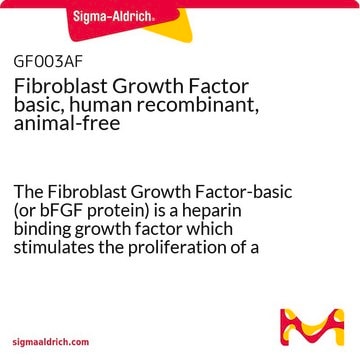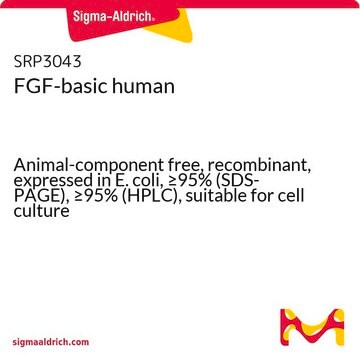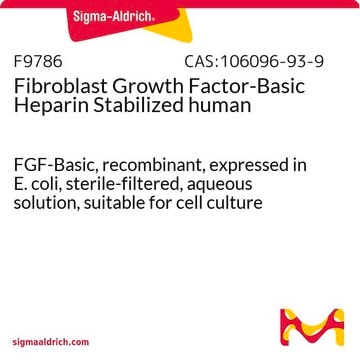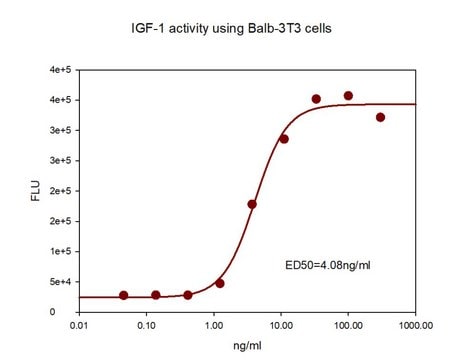SRP2092
FGF-2 human
recombinant, expressed in insect cells, ≥85% (SDS-PAGE)
Synonym(s):
BFGF, FGFB, HBGF-2
Sign Into View Organizational & Contract Pricing
All Photos(1)
About This Item
UNSPSC Code:
12352202
NACRES:
NA.26
Recommended Products
biological source
human
recombinant
expressed in insect cells
Assay
≥85% (SDS-PAGE)
form
frozen liquid
mol wt
~32.5 kDa
packaging
pkg of 5 μg
storage condition
avoid repeated freeze/thaw cycles
concentration
350 μg/mL
color
colorless to clear
NCBI accession no.
UniProt accession no.
shipped in
dry ice
storage temp.
−70°C
Gene Information
human ... FGF2(2247)
Application
FGF2 (fibroblast growth factor 2)-human has been used to study the role of FGF2 on steroidogenesis and survival of cultured buffalo granulosa cells. It has been used as a control to study activated α2-macroglobulin mediated Müller glial cell migration.
Biochem/physiol Actions
Acidic fibroblast growth factor (FGF-1) and basic fibroblast growth factor (FGF-2) are ubiquitous cytokines found in many tissues. They have effects on multiple cell types derived from mesoderm and neuroectoderm, including endothelial cells. FGF proteins are small peptides of 155 to 268 amino acid residues. The degree of sequence identity between different family members is 30-60 % in a "central domain" of approx. 120 amino acids. This domain confers to FGFs a common tertiary structure and the ability to bind to heparin. Secreted FGFs signal to target cells by binding and activating cell-surface tyrosine kinase FGF receptors (FGFRs; 6, 7). The function of FGFs and FGFRs during embryonic development and adult physiology has been addressed by gain- and loss-of-function experiments in several animal model organisms. These studies have shown that FGFs act as key regulators of developmental events.
Physical form
Clear and colorless frozen liquid solution
Preparation Note
Use a manual defrost freezer and avoid repeated freeze-thaw cycles. While working, please keep sample on ice.
Storage Class Code
10 - Combustible liquids
WGK
WGK 1
Flash Point(F)
Not applicable
Flash Point(C)
Not applicable
Certificates of Analysis (COA)
Search for Certificates of Analysis (COA) by entering the products Lot/Batch Number. Lot and Batch Numbers can be found on a product’s label following the words ‘Lot’ or ‘Batch’.
Already Own This Product?
Find documentation for the products that you have recently purchased in the Document Library.
Customers Also Viewed
Li Liu et al.
Biomaterials, 35(24), 6259-6267 (2014-05-09)
Nanofibrous gelatin substrates are suited for long-term expansion of human pluripotent stem cells (hPSCs) under feeder- and serum-free culture conditions. A combinatorial library with different sets of processing parameters was established to assess the culture performance of hPSCs on nanofibrous
M A Nugent et al.
The international journal of biochemistry & cell biology, 32(2), 115-120 (2000-02-25)
Fibroblast growth factor-2 (FGF-2) is a member of a large family of proteins that bind heparin and heparan sulfate and modulate the function of a wide range of cell types. FGF-2 stimulates the growth and development of new blood vessels
S R Mishra et al.
Research in veterinary science, 108, 98-111 (2016-09-25)
The present study investigated the expression and localization of FGF and its functional receptors in the follicle of buffalo and the treatment of FGF2 on mRNA expression of CYP19A1 (aromatase), PCNA, and BAX (BCL-2 associated X protein) in cultured buffalo
L De Moerlooze et al.
Development (Cambridge, England), 127(3), 483-492 (2000-01-13)
The fibroblast growth factor receptor 2 gene is differentially spliced to encode two transmembrane tyrosine kinase receptor proteins that have different ligand-binding specificities and exclusive tissue distributions. We have used Cre-mediated excision to generate mice lacking the IIIb form of
Toshihiro Uesaka et al.
The Journal of neuroscience : the official journal of the Society for Neuroscience, 35(27), 9879-9888 (2015-07-15)
Elucidation of the cellular identity of neuronal precursors provides mechanistic insights into the development and pathophysiology of the nervous system. In the enteric nervous system (ENS), neurogenesis persists from midgestation to the postnatal period. Cellular mechanism underlying the long-term neurogenesis
Our team of scientists has experience in all areas of research including Life Science, Material Science, Chemical Synthesis, Chromatography, Analytical and many others.
Contact Technical Service







